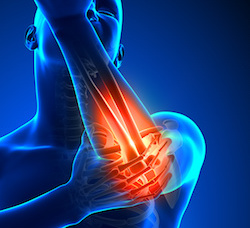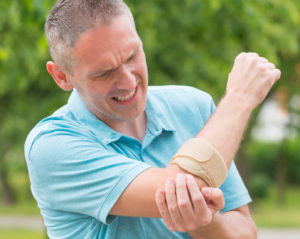WHAT IS TENNIS ELBOW?
 Lateral Epicondylitis, more commonly known as “tennis arm” or “tennis elbow” is a common condition among professional athletes as well as weekend warriors. Besides sports, the procedure also often affects patients who have to lift heavy in their occupation.
Lateral Epicondylitis, more commonly known as “tennis arm” or “tennis elbow” is a common condition among professional athletes as well as weekend warriors. Besides sports, the procedure also often affects patients who have to lift heavy in their occupation.
Tennis elbow is an injury caused by overuse which results in tears of the tendons that join the forearm muscles on the outside of the elbow. As its name implies, tennis elbow is a common condition among athletes who practice tennis and other racquet sports, however, several other sports and activities may lead to this condition.
Overuse of the tendons that join the forearm muscles to the outside of the elbow leads to inflammation, tenderness, and pain.
CAUSES OF TENNIS ELBOW
- Overuse. Studies show that tennis elbow usually occurs due to damage to a muscle called the extensor carpi radialis brevis (ECRB), which helps stabilize the wrist when the elbow is straight. The ECRB may become weakened or damaged when movements that require to straighten the elbow are repeated. This leads to inflammation and pain.
- Activities. Lateral Epicondylitis may affect any person who performs activities that require a repetitive and vigorous use of the forearm muscle, such as, auto workers, cooks, butchers, painters, carpenters, and plumbers. The repetitive movements and weight lifting required in these occupations may lead to injury.
- Age. Tennis elbow is most common among people between the ages of 30 and 50, although this disease may occur at any age.
- Unknown. Insidious lateral epicondylitis refers to the development of tennis elbow without a known history of overuse.
TREATMENT OPTIONS FOR TENNIS ELBOW
- Medical management. About 80% of the patients who suffer from tennis elbow are able to recover with nonsurgical treatment. The common treatment approaches include rest, analgesics to reduce pain, steroids to reduce inflammation, physical therapy, and lifestyle changes.
- Surgery. Surgical treatment may be considered for cases of tennis elbow in which nonsurgical treatments do not provide the necessary relief. The correct surgical approach will depend on many factors including the degree of damage to the tendons. As with any surgery, there are various risks that should be considered before pursuing surgical treatment of tennis elbow, including infection, nerve and blood vessel damage, and the loss of strength and flexibility on the arm.
- Platelet-rich plasma (PRP). Recent investigations support the use of PRP for the treatment of tennis elbow. According to the American Academy of Orthopedic Surgeons, PRP is a “very promising” nonsurgical therapeutic approach for lateral epicondylitis.

 Local Platelet Rich Plasma injections can be an effective non-surgical treatment option for elbow pain as it stimulates the regeneration of the elbow joint. The procedure is often performed on professional athletes after tendon tears to accelerate the wound healing process and have them return to sport sooner.
Local Platelet Rich Plasma injections can be an effective non-surgical treatment option for elbow pain as it stimulates the regeneration of the elbow joint. The procedure is often performed on professional athletes after tendon tears to accelerate the wound healing process and have them return to sport sooner.